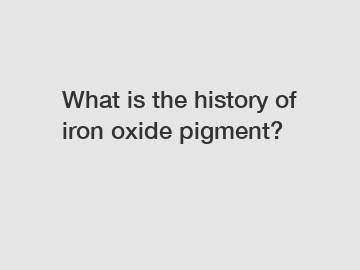What is the history of iron oxide pigment?
What is the history of iron oxide pigment?
Iron oxide pigment has a long and fascinating history that dates back thousands of years. This unique pigment, also known as rust, has been used by humans for various purposes throughout history. Let's delve into the ancient beginnings of iron oxide pigment and explore its significance.
1. Origins of Iron Oxide Pigment:

Iron oxide pigment can trace its origins to the earliest human civilizations. The ancient Egyptians were among the first to discover the vibrant red color produced by iron oxide, which they used to decorate pottery, create pigments for paintings, and even in religious ceremonies. These early civilizations recognized the beauty and versatility of iron oxide pigment, using it for decorative and symbolic purposes.
2. Natural Occurrence and Extraction:
Iron oxide pigment occurs naturally when iron reacts with oxygen in the presence of water or moisture. This reaction results in the formation of rust, a reddish-brown compound. In ancient times, people often noticed iron objects left outside would gradually transform into this pigment. They then started to explore ways to extract and use iron oxide pigment intentionally. Mining naturally occurring deposits of iron oxide or utilizing iron-containing minerals became common methods for obtaining the pigment.
3. Medieval Period and Renaissance:
During the medieval period, iron oxide pigment continued to gain popularity. Artists discovered that iron oxide pigment could create an array of warm earth tones, including various shades of red, brown, and yellow. The pigment's versatility made it a valuable addition to artists' palettes. Additionally, iron oxide pigmentsoxide pigments were also used to color textiles and dye fabrics, allowing for the creation of more vibrant and visually striking garments.
With the onset of the Renaissance, iron oxide pigments began to be utilized in large-scale architectural projects. The rich red and brown hues of iron oxide pigments were employed in the creation of exquisite frescoes and murals that adorned churches, palaces, and other architectural wonders. Artists such as Leonardo da Vinci and Michelangelo frequently employed iron oxide pigments to bring life and depth to their masterpieces.
4. Industrial Revolution and Modern Applications:
The Industrial Revolution marked a turning point in the history of iron oxide pigment. With the advent of industrial processes and advancements in chemistry, the production of iron oxide pigments became more efficient. This led to their widespread availability and affordability, making them accessible to a broader range of industries and individuals.
In the modern era, iron oxide pigments have found numerous applications. They are commonly used in the manufacturing of paints, coatings, plastics, and ceramics. The vibrant red, brown, and yellow shades they produce add visual appeal to various everyday products. Moreover, iron oxide pigments have been extensively used in the construction industry to color concrete, giving buildings a more aesthetically pleasing appearance.
5. Environmental Impact and Safety Considerations:
While iron oxide pigments are generally regarded as safe for use, it is essential to consider their environmental impact. As the production of iron oxide pigments requires the extraction of iron-containing minerals, mining activities can have adverse ecological effects if not properly managed. It is crucial to implement sustainable mining practices to minimize environmental damage and ensure the responsible sourcing of these pigments.
In conclusion, the history of iron oxide pigment spans thousands of years, leaving an indelible mark on human civilization. From its early uses in ancient Egypt to its widespread industrial applications today, iron oxide pigment continues to be invaluable to various industries and artistic pursuits. The versatile and visually appealing hues it produces have allowed for the creation of vibrant artworks and colorful everyday products. However, it is vital that we prioritize sustainable practices to minimize the ecological impact of extracting these pigments. As we move forward, let us continue to appreciate and responsibly utilize the rich history and potential of iron oxide pigment.
Contact us to discuss your requirements of Iron Oxide Colors for Roofing, iron oxide pigment for mortar. Our experienced sales team can help you identify the options that best suit your needs.
234
0
0

Comments
All Comments (0)